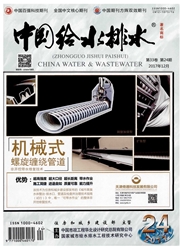

 中文摘要:
中文摘要:
采用光电组合法同时实现了罗丹明B的氧化降解和Cu^2+的回收。TiO2/Ti薄膜电极作为光电催化阳极,光电催化产生的氧化剂可有效氧化罗丹明B;不锈钢作为光电催化反应阴极,游离的Cu^2+在阴极得到电子被还原沉积回收。针对5mg/L罗丹明B和0.2mmol/L Cu^2+的混合体系,光电催化氧化技术、光催化氧化与电化学氧化过程对罗丹明B的去除率分别为80%、50%、40%,对Cu“的回收率分别为78%、8%、60%,可见光电组合具有良好的协同作用。光电组合处理罗丹明B和Cu^2+的最佳pH值为3.5、电流密度应控制在0.3~0.6mA/Cm^2。研究结果显示光电催化技术可作为罗丹明B和Cu^2+混合废水的一种处理方法。
 英文摘要:
英文摘要:
Photoelectrocatalytic oxidation was used to treat simulated wastewater containing rhoda- mine B and Cu2+ ions. TiO2/Ti thin film was used as the photoanode which produced strong oxidant to oxidize rhodamine B under UV light irradiation. Stainless steel was used as photocathode on which Cu^2+ ions were reduced and recovered by electrodeposition. The removal rates of rhodamine B were 80% , 50% and 40% , and the recovery rates of Cu^2+ were 78% , 8% and 60% when the wastewater containing 5 mg/L rhodamine B and 0.2 mmol/L Cu^2+ was treated by photoelectroncatalytic oxidation, photocatalyt- ic oxidation and electrochemical oxidation, respectively. The optimum pH of photoelectroncatalytic oxida- tion was 3.5, and the current density should be controlled between 0.3 and 0.6 mA/cm2. Photoelectron- catalytic oxidation technology is an effective method to treat rhodamine B and Cu2+ ions mixed wastewater.
 同期刊论文项目
同期刊论文项目
 同项目期刊论文
同项目期刊论文
 Photoelectrocatalytic oxidation of Cu-EDTA complex and electrodeposition recovery of Cu in a continu
Photoelectrocatalytic oxidation of Cu-EDTA complex and electrodeposition recovery of Cu in a continu Efficient treatment of an electroplating wastewater containing heavy metal ions, cyanide, and organi
Efficient treatment of an electroplating wastewater containing heavy metal ions, cyanide, and organi Characterization ofdissolvedorganicmatterfromsurfacewaterswith low tohighdissolvedorganiccarbonandth
Characterization ofdissolvedorganicmatterfromsurfacewaterswith low tohighdissolvedorganiccarbonandth Facile Synthesis of Graphite-Reduced Graphite Oxide Core?Sheath Fiber via Direct Exfoliation of Carb
Facile Synthesis of Graphite-Reduced Graphite Oxide Core?Sheath Fiber via Direct Exfoliation of Carb Graphene-modified Pd/C cathode and Pd/GAC particles for enhanced electrocatalytic removal of bromate
Graphene-modified Pd/C cathode and Pd/GAC particles for enhanced electrocatalytic removal of bromate Photoelectrocatalytic Oxidation of Cu-cyanides and Cu-EDTA at TiO2 nanotube electrodePhotoelectrocat
Photoelectrocatalytic Oxidation of Cu-cyanides and Cu-EDTA at TiO2 nanotube electrodePhotoelectrocat Facile Synthesis of Graphite-Reduced Graphite Oxide Core Sheath Fiber via Direct Exfoliation of Carb
Facile Synthesis of Graphite-Reduced Graphite Oxide Core Sheath Fiber via Direct Exfoliation of Carb Electrochemical Reduction of Bromate by a Pd Modified Carbon Fiber Electrode: Kinetics and Mechanism
Electrochemical Reduction of Bromate by a Pd Modified Carbon Fiber Electrode: Kinetics and Mechanism Electrochemical removal of haloacetic acids in a three-dimensional electrochemical reactor with Pd-G
Electrochemical removal of haloacetic acids in a three-dimensional electrochemical reactor with Pd-G Simultaneous destruction of Nickel (II)-EDTA with TiO2/Ti film anode and electrodeposition of nickel
Simultaneous destruction of Nickel (II)-EDTA with TiO2/Ti film anode and electrodeposition of nickel 期刊信息
期刊信息
